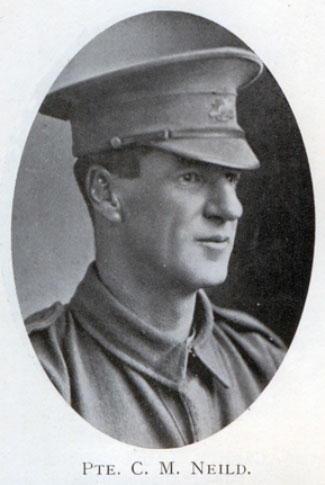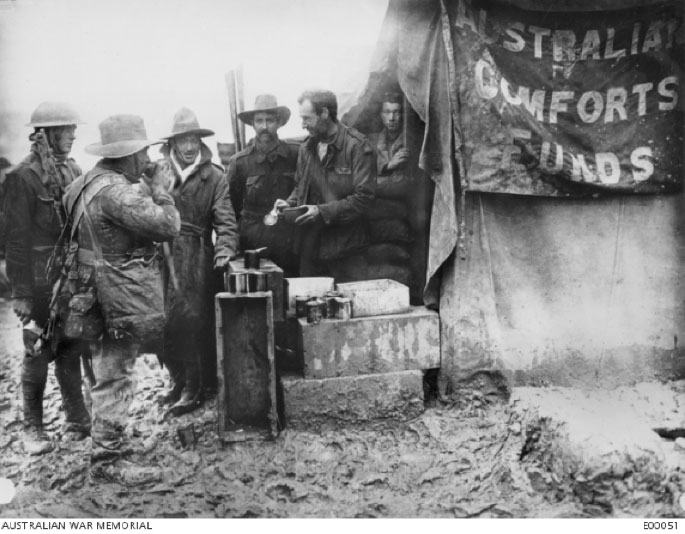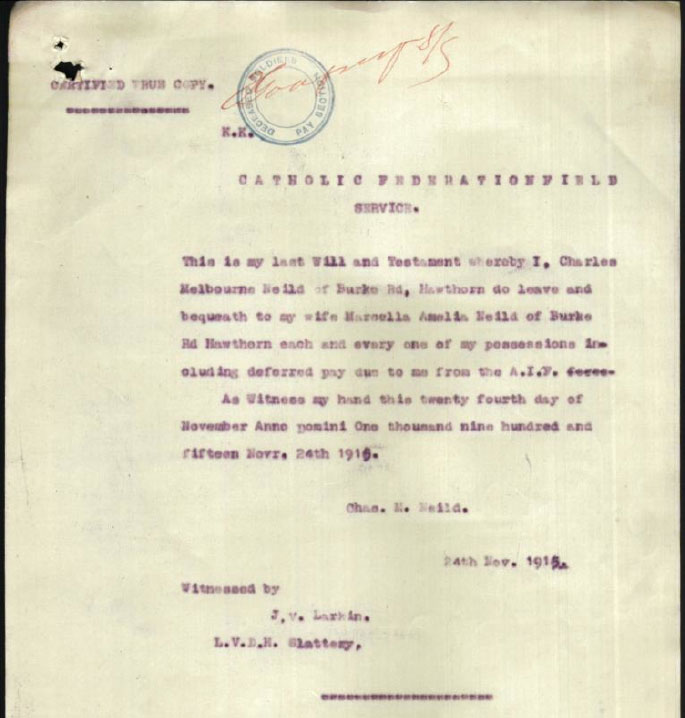War Memorial Hall c1929

Charles Melbourne NEILD

Charles Neild was born on 21 October 1870 in Melbourne, Victoria. His parents were Dr James Edward and Susannah Maria (née Long) Neild. He attended Scotch from 1883 to 1889. His obituary in The Scotch Collegian said he had been a ‘straightforward, hard-working and intelligent lad’.
Charles was an architect when he enlisted on 7 July 1915 in Melbourne. He served in the 8th Battalion with the rank of Private. His Regimental Number was 3209.
Charles died on 27 March 1917 at Bapaume, France. He was 46 years of age.
Service record
‘Charlie’ Neild enlisted at the age of 44. He was in a Depot Battalion for more than four months before being allotted to reinforcements to the 24th Battalion in November and then, in Egypt, to the 8th Battalion in February 1916. He reached Marseille, France, with his unit at the end of March 1916. He survived the fighting at Pozieres, where 81 members of his battalion were killed. In October 1916 he was temporarily attached to the 4th Field Ambulance for duty, which comprised working with the Australian Comforts Fund.
It was while he was on this duty that a well-known photograph, apparently including Charles, was taken on the Somme front in December 1916 (see below). It shows him and another soldier distributing food to troops at a famous Australian Comforts Fund tea and coffee stall at Longueval. While doing this work, he was killed in action.
His obituary in the 1917 Scotch Collegian says that Charlie and six other ‘Comforts’ men were killed by an explosion at Bapaume. This was almost certainly the infamous explosion of a delayed action German mine that destroyed the town hall at Bapaume on the night of 25/26 March. An Australian government website says that Charles Neild was killed in this explosion. Neild’s official date of death was 27 March, but he was probably killed in the mine explosion.
Officially Charles was still in the 8th Battalion at the time, but that unit was training at Boire. On receiving the news of the death of Neild and his fellow ACF men, the commander of the I Anzac Corps, Lieutenant General Sir William Birdwood, wrote: ‘I exceedingly regret this. No one knows better than I the real good work they have done for us since the start, and no one more fully appreciates the self-sacrifice shown in their work on behalf of the men. We do, indeed, owe a very deep debt of gratitude to the Comforts Fund and all connected with it, for time after time it has just made all the difference to the men to be able to get the comforts provided by the funds.’
In Charles’ obituary an unnamed officer and friend praised his kindness in word and action and called him ‘in every way one of Nature’s gentlemen.’ In his will Charles had left all his possessions to his wife (see below). One of his mates told her in a letter that his damaged watch had been recovered after the fatal explosion, but despite inquiries from her and the authorities it apparently never reached her.
Charles Neild is buried in the Bapaume Australian Cemetery, (Row A, Grave 29), Bapaume, France.
Photographs and Documents:

The original caption to this December 1916 photograph is: ‘The conditions immediately behind the front during the Somme winter. Infantrymen drinking coffee at the Australian Comforts Fund stall. The men serving at this stall are 3774 Private (Pte) A Gunn and 3209 Pte C Neild. Pte Gunn was killed on 25 March 1917 when the Bapaume Town Hall was blown up by a delayed German mine. Pte Neild was killed in action on 27 March 1917 at Bapaume.’

Charles Neild’s will
Sources:
- Australian War Memorial – Roll of Honour
- Australians on the Western Front website, ‘Bapaume Town Hall’ - http://www.ww1westernfront.gov.au/bullecourt/bapaume/bapaume-town-hall.php
- Mishura Scotch Database
- National Archives of Australia – B2455, NEILD CHALRES (sic)


